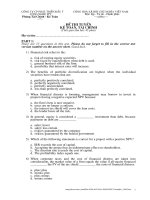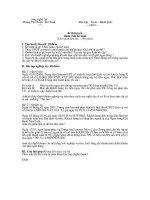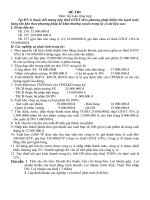Đề thi tuyển kế toán viên P2
Bạn đang xem bản rút gọn của tài liệu. Xem và tải ngay bản đầy đủ của tài liệu tại đây (80.16 KB, 3 trang )
công ty CP phát triển đầu t Cộng hoà x hội chủ nghĩa Việt namã
công nghệ fpt Độc lập - Tự do - Hạnh phúc
Phòng Tài Chính - Kế Toán ---=o0o=---
--*--
đề thi tuyển
Kế toán, tàI chính
(Thời gian làm bài: 45 phút)
Họ và tên:.................................................................
Part 1:
There are 13 questions in this test. Please do not forget to fill in the correct test
version number on the answer sheet. Good luck.
1) Financial risk refers to the:
a. risk of owning equity securities.
b. risk faced by equityholders when debt is used.
c. general business risk of the firm.
d. possibility that interest rates will increase.
2) The benefits of portfolio diversification are highest when the individual
securities have returns that are:
a. perfectly positively correlated.
b. perfectly negatively correlated.
c. perfectly uncorrelated.
d. less than perfectly correlated.
3) When financial disaster is looming, management may borrow to invest in
projects having a negative expected NPV because:
a. the firm's beta is now negative.
b. taxes are no longer a concern.
c. the interest tax shield will cover the loan costs.
d. the lender bears all the risk.
4) In general, equity is considered a __________ investment than debt, because
payments on debt are __________.
a. safer; lower
b. safer; less certain
c. riskier; guaranteed by the company
d. riskier; guaranteed by the federal government
5) Which of the following statements is correct for a project with a positive NPV?
a. IRR exceeds the cost of capital.
b. Accepting the project has an indeterminate effect on shareholders.
/var/www/html/tailieu/data/upload/12/ve/ym/ymq1351742159.doc
1
c. The discount rate exceeds the cost of capital.
d. The profitability index equals one.
6) When corporate taxes and the cost of financial distress are taken into
consideration, the market value of a firm equals the value if all-equity financed
__________ the PV of the tax shield __________ the costs of financial distress.
a. plus; plus
b. minus; plus
c. plus; minus
d. minus; minus
7) When projects are mutually exclusive, selection should be made according to
the project with the:
a. highest IRR.
b. lowest IRR.
c. incremental cash flows.
d. highest NPV.
8) A stock's beta measures the:
a. average return on the stock.
b. variability in the stock's returns compared to that of the market portfolio.
c. difference between the return on the stock and return on the market portfolio.
d. market risk premium on the stock.
9) Your broker suggests that you can make consistent, excess profits by ________
purchasing stocks on the 20th of the month and selling them on the last day of
the month. If this is true, then:
a. the market is only semi-strong-form efficient.
b. the market violates even weak-form efficiency.
c. insiders will be the only investors to profit.
d. prices follow a random walk.
10) If a stock's price decreased during the past week, what is the most likely
prediction about this week's price change?
a. Price will reverse last week's loss and go up.
b. Price will continue last week's decline.
c. Price will stand still until new information is released.
d. Either direction of price change is equally likely.
11) If the coupon rate is lower than current interest rates, then the yield to maturity
will be:
a. lower than current interest rates.
b. equal to the coupon rate.
c. higher than the coupon rate.
d. lower than the coupon rate.
/var/www/html/tailieu/data/upload/12/ve/ym/ymq1351742159.doc
2
12) The major benefit of diversification is to:
a. increase the expected return.
b. increase the size of the investment portfolio.
c. reduce brokerage commissions.
d. reduce the expected risk.
13) ABC Corporation has fallen upon hard times and dividends on their non-
cumulative, preferred stock have not been paid for three years. Which of the
following is true?
a. Common shareholders must now receive three years' worth of dividends.
b. Preferred shareholders must now receive three years' worth of dividends.
c. The corporation must fold if preferred shareholders are not paid.
d. Common shareholders have not received dividends for three years.
Part II:
1) Chênh lệch tỷ giá cuối kỳ xử lý vào đâu? Tại sao lại quy định nh vậy ?
2) Viết định khoản kế toán của nghiệp vụ công nợ phải thu sau :
- Ngày 01/01/2002, khách hàng A mua Công ty FPT số lợng hàng hoá (Cha bao
gồm thuế GTGT) gía trị 10,000$, giá vốn là 9,000$, VAT 10%, hạn trả nợ sau
5 ngày.
- Đến ngày 10/1/2002, khách hàng trả bằng tiền mặt đợc 5,000$
- Sau đó, nhân viên công ty FPT phát hiện ra khách hàng mất khả năng chi trả và
phải thuê cơ quan chức năng thu hồi nợ. Sau 30 ngày (Ngày 10/02/2002) , mới
thu đợc nốt số tiền mà khách hàng còn nợ, phí phải trả cho số tiền đòi đợc là
20% trên tổng số tiền thu đồi đợc, Công ty FPT trả ngay số tiền này bằng
chuyển khoản qua Ngân hàng.
Trong thời gian từ ngày 10/1 đến khi thu đợc nợ, anh/chị phải làm gì với từ cách là Kế
toán quản lý công nợ.
End
/var/www/html/tailieu/data/upload/12/ve/ym/ymq1351742159.doc
3









